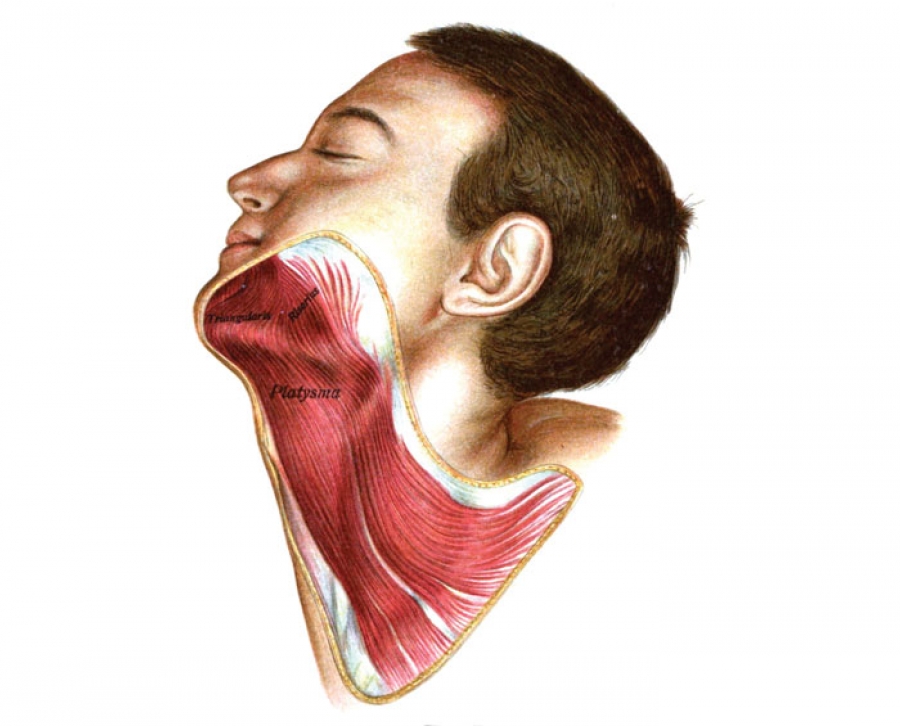Like the eyes, our neck is highly susceptible to premature aging because of its anatomical composition and vulnerability to sun damage. From facial exercises to surgical intervention, there is no shortage of remedies for aging necklines, double chins or discolorations of the neck. In order to give the best advice for neck rejuvenation, we must first understand its components and what the real solutions are to achieve complete beauty.

 1. Our ability to depress the jaw and frown comes from a sheet of muscle called the platysma. It spans from the mandible to the upper part of our pectoralis major muscle of the chest and clavicle. This frontal sheet covers a network of smaller muscles, lymphatic sites, arteries and veins, and gives the neck its shape from the chin to the collarbone.
1. Our ability to depress the jaw and frown comes from a sheet of muscle called the platysma. It spans from the mandible to the upper part of our pectoralis major muscle of the chest and clavicle. This frontal sheet covers a network of smaller muscles, lymphatic sites, arteries and veins, and gives the neck its shape from the chin to the collarbone.
2. Lymphatic drainage techniques utilize the cervical lymph nodes located near the clavicle, mandible, cervical spine, and behind the ear. When performing lymphatic drainage techniques in a facial, work from the center of the face (points of interest in this technique include the forehead, nose, upper lip and chin) out towards the ears. From the ears, massage down toward the thyroid. Massaging to work excess fluid and cellular waste via this process helps refine facial features and improve your client’s overall look.
 3. The skin of the neck is more susceptible to folding and creasing, leaving one or more horizontal lines in the skin. These lines are indicative of Langer’s lines or cleavage lines. Our entire skin organ can be mapped out with these lines; but in the case of our neck, they run horizontally.
3. The skin of the neck is more susceptible to folding and creasing, leaving one or more horizontal lines in the skin. These lines are indicative of Langer’s lines or cleavage lines. Our entire skin organ can be mapped out with these lines; but in the case of our neck, they run horizontally.
4. Neck creases and deep wrinkles can age the look of the neck. This happens when the platysma muscle begins to feel the weight of gravity and facial bones begin to compress. Plastic surgeons can lift the neck by pulling the skin and muscle from the jaw back toward the ear. Try pushing your fingers (with ample pressure) under your jaw and out toward your ears to see the lifting effect.
 5. Neck furrows or bands are characterized as two prominent and hard lines that run from the chin down to the clavicle. Age, genetics, skin thickness and lifestyle may all contribute to the severity and depth of these furrows. Because they emerge from the platysma muscle, the ideal solution to remove or reduce them is with surgery. A plastic surgeon can help reshape the muscle and reduce the furrow.
5. Neck furrows or bands are characterized as two prominent and hard lines that run from the chin down to the clavicle. Age, genetics, skin thickness and lifestyle may all contribute to the severity and depth of these furrows. Because they emerge from the platysma muscle, the ideal solution to remove or reduce them is with surgery. A plastic surgeon can help reshape the muscle and reduce the furrow.
6. A double chin is a predisposition to genetics and weight. There are ultimately two culprits that cause a double chin: platysma muscle and fat pockets. There are a variety of online sources that advertise exercises and products to help lose a double chin; the platysma cannot be tightened and firmed like our triceps and biceps. You can minimize the appearance of a double chin with diet and exercise, makeup techniques, shirts or good upright posture. If these means of reducing the double chin are not enough, submental liposuction or surgery are the next options.
 7. Some medical practices advertise a neck-lifting alternative with the use of neurotoxin injections. The neurotoxin is injected into the platysma to relax the muscle and soften the furrow. Unfortunately, results are temporary and this is an off-label use of neurotoxin. Our neck has many vital components that may become compromised and there is ample opportunity to improperly place the neurotoxin. Surgical options may deliver long-lasting results.
7. Some medical practices advertise a neck-lifting alternative with the use of neurotoxin injections. The neurotoxin is injected into the platysma to relax the muscle and soften the furrow. Unfortunately, results are temporary and this is an off-label use of neurotoxin. Our neck has many vital components that may become compromised and there is ample opportunity to improperly place the neurotoxin. Surgical options may deliver long-lasting results.
8. The dreaded turkey neck (or wattle) is characterized as loose, crepey and sagging skin of the neck and is associated with aging. Transforming the look of this neck may be done with non-invasive procedures, depending on the laxity of the skin and the overall look the client wants to achieve. Ultrasonic, laser and radio frequency technologies have proven to be beneficial at heating the deeper layers of skin to promote healing and repair (for example, stimulate collagen synthesis and tighten the skin). For moderate to severe skin laxity, a neck lift may offer a more dramatic result.
 9. Discolorations can age the neck. Hyperpigmentation can be minimized with antioxidant and sunscreen use daily. Sun damage can cause discoloration called poikiloderma, which is a condition of the neck characterized by hyperpigmentation, hypopigmentation, telangiectasias and an overall thin, dehydrated look. Correcting poikiloderma using intense pulsed light (IPL) technology is highly effective because it treats red and brown lesions simultaneously. Another form of hyperpigmentation called acanthosis nigricans is characterized as ashy or velvety patches on the neck and folds of skin. Diabetes, polycystic ovarian syndrome or other health issues may be the cause of the discolorations and the client should seek medical advice.
9. Discolorations can age the neck. Hyperpigmentation can be minimized with antioxidant and sunscreen use daily. Sun damage can cause discoloration called poikiloderma, which is a condition of the neck characterized by hyperpigmentation, hypopigmentation, telangiectasias and an overall thin, dehydrated look. Correcting poikiloderma using intense pulsed light (IPL) technology is highly effective because it treats red and brown lesions simultaneously. Another form of hyperpigmentation called acanthosis nigricans is characterized as ashy or velvety patches on the neck and folds of skin. Diabetes, polycystic ovarian syndrome or other health issues may be the cause of the discolorations and the client should seek medical advice.
10. Skin of the neck is characterized with higher water content, slower cellular turnover, higher elasticity and is overall thin in comparison to the face. It is also highly susceptible to sun damage and discolorations. Like the face, the skin of the neck should be cared for at a young age to help keep it supple, smooth and even toned. Start with sunscreen; it is the best way to prevent premature aging. To rejuvenate the neck and maintain a youthful appearance, look for specially formulated neck creams with collagen promoting and protecting ingredients like antioxidants and amino peptides.
The neck can be a troublesome area to treat without knowledge of the anatomy and underlying structures that contribute to visibly aged skin. Folds and creases tend to develop prematurely and addressing intrinsic aging with bone and muscle changes can be costly surgical procedures. Whether a client chooses minimal or maximum intervention, always be there to offer them the best advice in order to age gracefully and maintain their results.
 Tina Zillmann is the founder of Advanced Rejuvenating Concepts and Skin Rejuvenation Clinique. As a business owner, aesthetician, product developer, and licensed laser professional, she is fluent on all aspects of the aesthetic business. She has been awarded on television and print as a local skin care expert in San Antonio, Texas and nationally as a public speaker and published writer in the skin care industry.
Tina Zillmann is the founder of Advanced Rejuvenating Concepts and Skin Rejuvenation Clinique. As a business owner, aesthetician, product developer, and licensed laser professional, she is fluent on all aspects of the aesthetic business. She has been awarded on television and print as a local skin care expert in San Antonio, Texas and nationally as a public speaker and published writer in the skin care industry.
